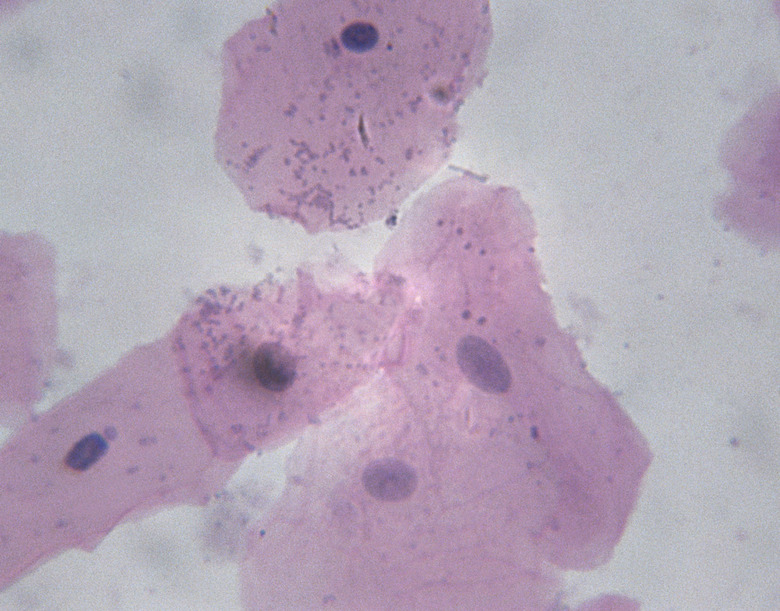What Enzyme Is Responsible For Elongating The RNA Chain?
Ribonucleic acid, or RNA, plays several vital roles in the life of a cell. It acts as a messenger, relaying the genetic code from deoxyribonucleic acid, or DNA, to the cell's protein-synthesizing machinery. Ribosomal RNA joins with proteins to form ribosomes, the cell's protein factories. Transfer RNA shuttles amino acids into growing protein strands as ribosomes translate messenger RNA. Other forms of RNA help control cell activity. The enzyme RNA polymerase, or RNAP, which has several forms, is responsible for elongating the RNA chain during the transcription of DNA.
RNA Polymerase Structure
RNA Polymerase Structure
In eukaryotic cells — that is, cells with organized nuclei — the different RNAP types are labeled I through V. Each has a slightly different structure and each creates a different set of RNAs. For example, RNAP II is responsible for creating messenger RNA, or mRNA. Prokaryotic cells (which do not have organized nuclei) have one type of RNAP. The enzyme consists of several protein subunits that perform various functions during transcription. An active site containing a magnesium atom is the location within the enzyme at which RNA elongates. The active site adds sugar-phosphate groups to the growing RNA strand and attaches nucleotide bases according to the base-pairing rules.
Base Pairing
Base Pairing
DNA is a long molecule with a backbone composed of alternating sugar and phosphate units. One of four nucleotide bases — single- or -double-ringed molecules containing nitrogen — hangs off each sugar unit. The four DNA bases are labeled A, T, C, and G. The sequence of base pairs along the DNA molecule dictates the sequence of amino acids in the proteins synthesized by the cell. DNA usually exists as a double helix in which the bases of two strands bind to each other according to base-paring rules: the A and T bases form one set of pairs, while C and G form the other set. RNA is a related, single-stranded molecule that observes the same base-pairing rules during DNA transcription, except for the substitution of the U base for T in RNA.
Transcription Initiation
Transcription Initiation
Protein initiation factors must form a complex with a molecule of RNA polymerase before transcription can begin. These factors enable the enzyme to bind to promoter regions — attachment points for different transcription units — on a DNA strand. Transcription units are sequences of one or more genes, which are the protein-specifying portions of a DNA strand. The RNA polymerase complex creates a transcription bubble by unzipping a portion of the DNA double helix at the start of the transcription unit. The enzyme complex then begins assembling RNA by reading the DNA template strand one base at a time.
Elongation and Termination
Elongation and Termination
The RNA polymerase complex might make many false starts before elongation begins. In a false start, the enzyme transcribes about 10 bases and then aborts the process and restarts. Elongation can begin only when the RNAP releases the initiating protein factors anchoring it to the DNA promoter region. Once elongation is underway, the enzyme enlists elongation factors to help move the transcription bubble down the DNA strand. The moving RNAP molecule elongates the new RNA strand by adding sugar-phosphate units and nucleotide bases that complement the bases on the DNA template. If the RNAP discovers a mispaired base, it can cleave and resynthesize the errant RNA segment. Transcription ends when the enzyme reads a stop sequence on the DNA template. At termination, the RNAP enzyme releases the RNA transcript, the protein factors and the DNA template.
References
- University of California Berkeley: Three Types of RNA Polymerase in Eukaryotic Nuclei
- Nature Structural & Molecular Biology: Structure and Mechanism of the RNA Polymerase II Transcription Machinery
- Chemguide: Transcription — From DNA to RNA
- Genes & Development: Elongation by RNA Polymerase II: The Short and Long of It
Cite This Article
MLA
Finance, Eric Bank, MBA, MS. "What Enzyme Is Responsible For Elongating The RNA Chain?" sciencing.com, https://www.sciencing.com/enzyme-responsible-elongating-rna-chain-16182/. 24 April 2017.
APA
Finance, Eric Bank, MBA, MS. (2017, April 24). What Enzyme Is Responsible For Elongating The RNA Chain?. sciencing.com. Retrieved from https://www.sciencing.com/enzyme-responsible-elongating-rna-chain-16182/
Chicago
Finance, Eric Bank, MBA, MS. What Enzyme Is Responsible For Elongating The RNA Chain? last modified August 30, 2022. https://www.sciencing.com/enzyme-responsible-elongating-rna-chain-16182/
